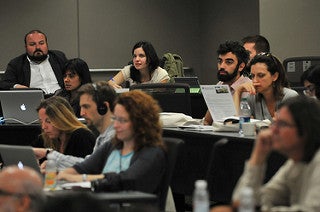June 3, 2013 | Coloquio
Digital media discuss their sustainability during 6th Ibero-American Colloquium for Online Journalism
Finding new business models and reaching sustainability were the most important topics for journalists from digital media outlets in Latin America, Spain and Portugal during the most recent Ibero-American Colloquium for Online Journalism, wrote Anne Nelson of Columbia University in a special report for the Knight Center for Journalism in the Americas.

The Sixth Ibero-American Colloquium took place on April 20 and 21, immediately after the Online Symposium for Online Journalism, also organized by the Knight Center. The event gathered dozens of journalists from Latin America and the Iberian Peninsula, and explored three main topics: the sustainability of young news sites, the diversification of their revenue and the expansion of their audiences.
In her report, Nelson details the main messages and conclusions that emerged from the colloquium. The event began with a panel from John Thorton — the venture capitalist that founded the successful state politics news site Texas Tribune, who talked with the colloquium’s participants about the different methods the publication has employed to diversify its earnings — and Kevin Davis, director of the Investigative News Network, INN, who went over the different legal and administrative services that they offer to support budding news sites in the U.S.
On the second day of the event participants discussed in more detail the different sources of revenue that young news sites in the region can tap into. Davis described the three main types of revenue: direct (e.g.: traditional promotion of digital content), indirect (e.g.: philantropic support) and ancillary (e.g.: earnings through training, events and other services).

Participants also talked about the dependence many of them still have on grants from foundations — like the Open Society Foundations — and the need to carefully study their markets and strengths to understand the best methods to diversify their earnings.
After discussing some of the models that U.S. news websites have employed, Nelson said that Latin American and Iberian publications could learn a lot from their American colleagues but not follow the same path due to the differences between the regions, like the technological lag in Latin America, where print publications are still strong.
However, Nelson pointed out the enormous opportunities for the young media outlets that obtain a position of leadership in today’s digital landscape.
“As the technological infrastructure advances, the legacy advantage will diminish, and markets will favor those organizations that manage the transition well – though their paths may not replicate those in the U.S.,” Nelson wrote.
During the event, 14 websites from Latin America and Spain also made presentations showcasing their publications, like Animal Político, which has had enormous success in Mexico catering for a younger market, Nicaragua’s Confidencial, which is one of several publications working to build a network of Central American digital media outlets, and Mi Voz, a network of citizen journalists operating in Chile.
Click here to read Nelson’s full report on the event.

